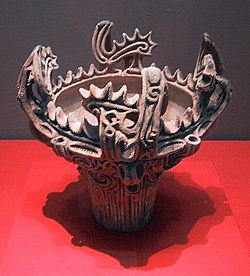National Treasure (Japan): Difference between revisions
This is a See Also section. Put it in National Treasures of South Korea where it is relavent... oh, it's already there. |
This information is profitable to explain the reason why only the national treasure of Korea is related to Japan. This information was related by the Korean user, and a Japanese user supplemente |
||
| Line 165: | Line 165: | ||
==See also== |
==See also== |
||
*[[Living National Treasure (Japan)]] |
*[[Living National Treasure (Japan)]] |
||
*[[National Treasures of South Korea]] (National Treasures of South Korea was introduced by Japan. <ref>朝鮮総督府宝物古蹟名勝天然記念物保存会官制(昭和8年勅令第224号) [http://www.geocities.jp/nakanolib/rei/rs08-224.htm] </ref>) |
|||
*[[National Treasures of South Korea]] |
|||
*[[Important Intangible Cultural Properties]] |
*[[Important Intangible Cultural Properties]] |
||
Revision as of 05:39, 12 January 2008
This article is missing information about Error: you must specify what information is missing.. |


The Ministry of Education, Culture, Sports, Science and Technology of the government of Japan designates the most famous of the nation's cultural properties as National Treasures (国宝: kokuhō). Examples of the types of works that receive this designation are
- Buildings such as castles, temples, shrines
- Paintings, scrolls, sutras, and works of calligraphy
- Statues in stone, bronze, wood, lacquer or other materials
- Crafts, such as pottery, lacquer ware, carvings, metals, netsuke, swords and textiles
- Archeological and historical artifacts, including burial objects, documents, and letters
- People, called "Living National Treasures (人間国宝: ningen kokuhō)"
Many of Japan's national treasures are in museums such as the national museums in Tokyo, Kyoto, and Nara. The prefectural and city governments also operate public museums, and these and private museums also house national treasures. Many Buddhist temples and Shinto shrines, castles and similar installations also open their buildings and grounds to the public, and some have museums as well. The Imperial Household of Japan holds many national treasures. Kyoto boasts about one in five national treasures.
Living National Treasure is an informal designation for a person whom the government has recognized as exemplary in carrying on Japanese traditions. Performing artists in genres including noh, bunraku, and kabuki, and artists and artisans in traditional crafts, have received this distinction.
Former and present national treasures
"National Treasure" has been used since 1897, though the term's pre-1950 and post-1950 significance is different. Before 1950, all the state-designated cultural properties were called "National Treasure"s. At that time, 5,824 art works and 1,059 buildings were National Treasures. On August 29, 1950, the Law for the Protection of Cultural Properties came into forced and all National Treasures became "Important Cultural Properties" (重要文化財: jūyō bunka zai). Some of them have been designated as new "National Treasures" since June 9, 1951.
The number of National Treasures of Japan
As of August 1, 2006, the numbers of national cultural properties are:
- National Treasures (arts and crafts): 860, of which there are:
- 233 in Tokyo
- 204 in Kyoto
- 143 in Nara
- 55 in Osaka
- 33 in Shiga prefectures
- National Treasures (structures): 213, of which there are:
- 64 in Nara
- 48 in Kyoto
- 22 in Shiga
- 11 in Hyogo
- 7 in Hiroshima and Wakayama Prefectures
| Prefecture | Building Structures | Art Works |
|---|---|---|
| Hokkaido | 0 | 0 |
| Aomori | 0 | 2 |
| Iwate | 1 | 7 |
| Miyagi | 3 | 3 |
| Akita | 0 | 1 |
| Yamagata | 1 | 4 |
| Fukushima | 1 | 2 |
| Ibaragi | 0 | 2 |
| Tochigi | 6 | 10 |
| Gunma | 0 | 0 |
| Saitama | 0 | 1 |
| Chiba | 0 | 8 |
| Tokyo | 1 | 233 |
| Kanagawa | 1 | 18 |
| Niigata | 0 | 1 |
| Toyama | 1 | 0 |
| Ishikawa | 0 | 3 |
| Fukui | 2 | 4 |
| Yamanashi | 2 | 3 |
| Nagano | 5 | 2 |
| Gifu | 3 | 3 |
| Shizuoka | 0 | 11 |
| Aichi | 3 | 6 |
| Mie | 0 | 4 |
| Shiga | 22 | 33 |
| Kyoto | 48 | 207 |
| Osaka | 5 | 55 |
| Hyogo | 11 | 9 |
| Nara | 64 | 143 |
| Wakayama | 7 | 29 |
| Tottori | 1 | 2 |
| Shimane | 2 | 2 |
| Okayama | 2 | 4 |
| Hiroshima | 7 | 12 |
| Yamaguchi | 3 | 6 |
| Tokushima | 0 | 0 |
| Kagawa | 2 | 4 |
| Ehime | 3 | 9 |
| Kochi | 1 | 1 |
| Fukuoka | 0 | 12 |
| Saga | 0 | 0 |
| Nagasaki | 3 | 0 |
| Kumamoto | 0 | 0 |
| Oita | 2 | 2 |
| Miyazaki | 0 | 0 |
| Kagoshima | 0 | 1 |
| Okinawa | 0 | 1 |
| *Total* | 213 | 860 |
Source: Database of National Cultural Properties, the Agency for Cultural Affairs of Japan.
Gallery
-
Horyu-ji Golden Hall and Pagoda
-
Horyu-ji Yumedono
-
Himeji castle Grand Tower
-
Byodoin Phoenix Hall
-
Kiyomizudera temple Main Hall
-
Nijo Castle Ninomaru Palace
-
Itsukushima Shrine Main Hall
-
Todai-ji temple Golden Hall
-
Yakushi-ji temple Eastern Tower
-
Nikko Toshogu Yomeimon Gate
-
KongouZanmaiin Tahoto Tower in Mt. Koya
External links
See also
- Living National Treasure (Japan)
- National Treasures of South Korea (National Treasures of South Korea was introduced by Japan. [1])
- Important Intangible Cultural Properties











